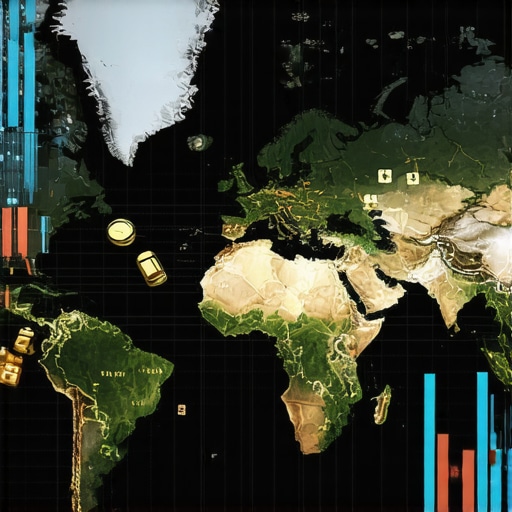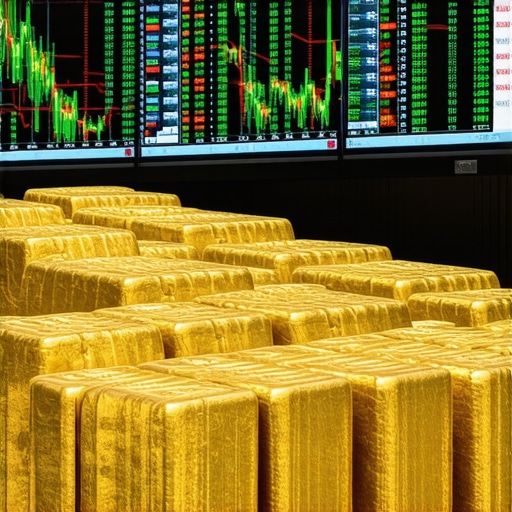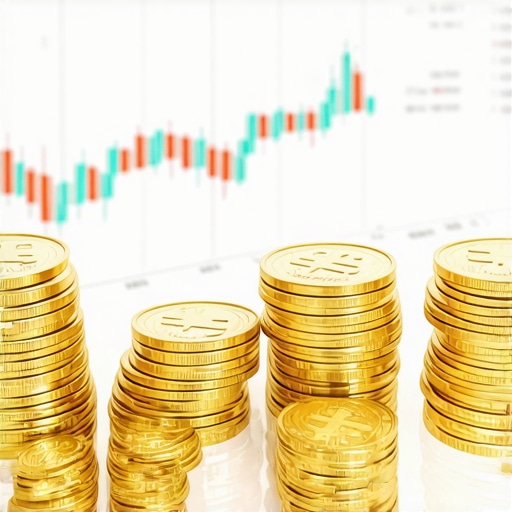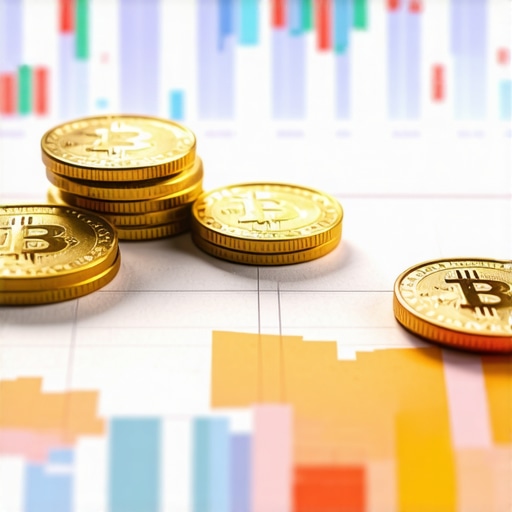Understanding the Nexus Between Global Economic Factors and Gold Price Trajectories in 2025
As we approach 2025, the intricate relationship between macroeconomic variables and gold prices demands a nuanced, expert-level understanding. Gold, often regarded as a safe-haven asset, reacts dynamically to shifts in international trade, monetary policies, and geopolitical tensions. This article explores the complex web of factors that will shape gold prices, emphasizing the importance of a multi-layered analytical approach rooted in economic theory and market intelligence.
Macro-Economic Variables Influencing Gold in 2025
How Will Inflation and Interest Rates Interact with Gold Demand?
Inflationary pressures, particularly in emerging markets and developed economies, are pivotal in driving gold demand. Historically, high inflation diminishes fiat currency value, prompting investors to seek the stability of gold. Concurrently, central banks’ monetary policies, including interest rate adjustments, influence gold’s attractiveness. A rising interest rate environment typically discourages gold investment due to opportunity costs, yet persistent inflation might counteract this trend, creating a complex balancing act for investors.
Geopolitical Tensions and Their Role in Shaping Gold Prices
The geopolitical landscape, characterized by trade disputes, regional conflicts, and diplomatic upheavals, acts as a catalyst for gold’s safe-haven appeal. In 2025, evolving geopolitical tensions could trigger surges in gold prices, especially if coupled with economic sanctions or currency devaluations. The recent analysis by the World Gold Council underscores the importance of political stability in maintaining gold’s allure as a hedge against uncertainty.
Market Dynamics and Investor Behavior in 2025
Emerging Trends in Gold Demand: A Deep Dive
Emerging demand from sectors such as technology, jewelry, and institutional investors will significantly impact gold prices. Technological innovations, including gold-backed cryptocurrencies and blockchain-based trading, might reshape investor engagement. Furthermore, the evolving landscape of gold ETFs and mutual funds offers accessible avenues for diversification, influencing liquidity and price stability.
What Are the Top Strategies for Navigating 2025’s Gold Market?
Expert investors should consider a diversified approach, combining physical gold holdings with futures and options strategies. Developing a long-term gold portfolio that accounts for inflation hedging and market volatility can mitigate risks. For detailed strategies, explore gold investment strategies for 2025.
How Will Central Bank Policies Shape the Gold Market in 2025?
Central banks remain key players, with their gold purchase policies directly influencing supply and demand. The strategic accumulation or divestment of gold reserves, especially by major economies like China and India, can sway prices significantly. A comprehensive understanding of these policies is vital; recent reports indicate that central banks are shifting towards increased gold reserves, potentially supporting higher price floors.
Final Thoughts: Navigating Complexity with Expertise
As the global economy evolves, so too will the forces influencing gold prices. An expert approach involves integrating macroeconomic data, geopolitical insights, and market sentiment analysis. Stakeholders should remain agile, continuously updating their models with real-time intelligence to capitalize on emerging opportunities.
For further insights, consider exploring how global economic factors will shape gold market trends in 2025 or contribute your professional expertise to ongoing discussions.
Decoding the Impact of Monetary Policy Shifts on Gold’s Future in 2025
Central banks worldwide are at a crossroads, balancing inflation control with economic growth. Their gold reserve management strategies—whether accumulating or divesting—directly influence supply-demand dynamics. Recent reports from the International Monetary Fund highlight a trend of increased gold reserves among emerging economies, notably China and India, which could underpin a price floor in 2025. Understanding these policy moves is crucial for investors aiming to anticipate market shifts and optimize their holdings.
How Will Technological Innovations Reshape Gold Investment Strategies?
The advent of blockchain technology and digital assets introduces new avenues for gold investment. Gold-backed cryptocurrencies and tokenized gold are gaining traction, providing liquidity and accessibility that traditional assets cannot match. These innovations challenge conventional investment paradigms, emphasizing the need for investors to stay informed about emerging platforms and regulatory environments. Experts suggest exploring emerging gold demand trends to understand their influence on prices and market behavior.
What Are the Critical Analytical Tools to Forecast Gold Prices in 2025?
Advanced analytical frameworks, such as technical analysis combined with macroeconomic modeling, are indispensable. Tools like gold futures technical analysis can help identify entry and exit points, while economic indicators, including inflation rates, interest rate forecasts, and currency strength, provide a broader context. Integrating these insights within a comprehensive decision-making process enhances predictive accuracy and investment resilience. For a practical approach, see how to use gold futures technical analysis in 2025.
The Future of Gold Demand: Beyond Traditional Markets
While jewelry and central bank reserves remain significant, emerging sectors like technology and institutional investment are shaping new demand profiles. Gold’s role in blockchain-based applications and as a hedge against evolving geopolitical risks continues to grow. According to a recent analysis by the World Gold Council, these shifts could lead to increased volatility but also present opportunities for strategic positioning. Staying ahead requires an understanding of emerging demand trends and their potential to influence future prices.
Have I Fully Considered the Multi-Dimensional Risks in Gold Investment Planning?
Expert investors recognize that risks extend beyond market fluctuations. Regulatory changes, technological disruptions, and geopolitical developments can all impact gold’s valuation. Developing a multi-layered risk management framework—incorporating scenario analysis, stress testing, and diversification—can help safeguard assets. For comprehensive strategies, consult develop a profitable gold IRA for retirement in 2025.
If you found this analysis valuable, consider sharing your insights or subscribing for updates on market forecasts. Staying informed is key to turning market complexities into opportunities for wealth preservation and growth.
Strategic Implications of Central Bank Gold Reserves and Monetary Policy Divergence in 2025
As global economies navigate uncharted waters, the divergence in monetary policies among major central banks becomes a focal point for gold market analysts. The Federal Reserve, European Central Bank, Bank of Japan, and emerging market central banks are adopting contrasting stances—ranging from quantitative tightening to aggressive easing—each influencing gold’s trajectory in unique ways. Particularly, the strategic accumulation of gold reserves by China and India signals a long-term shift in reserve management philosophies, potentially underpinning sustained price support.
This divergence is rooted in differing inflation trajectories, growth forecasts, and geopolitical considerations. For instance, while the Fed might maintain a cautious stance due to persistent inflation, emerging markets could pursue aggressive gold accumulation to hedge against currency devaluation. The International Monetary Fund (IMF) reports that such strategic shifts by central banks are critical in setting the tone for gold pricing, especially in the context of diminishing global liquidity and rising geopolitical tensions.
How Does Central Bank Reserve Management Influence Gold Price Stability?
Central banks’ reserve management strategies significantly impact liquidity and market perceptions. When major economies increase their gold holdings, it often signals a desire to diversify reserves away from fiat currencies susceptible to geopolitical risks or inflationary pressures. Conversely, divestment can lead to short-term price dips but might be part of broader currency stabilization efforts. Analyzing these trends requires a nuanced understanding of reserve composition disclosures and the geopolitical motivations behind them.
For example, the recent surge in gold purchases by the People’s Bank of China, documented in the IMF’s Global Financial Stability Report, underscores a strategic move aimed at bolstering national reserves amidst global uncertainties. Such moves are not only reflective of economic considerations but also serve as geopolitical signaling, making the gold market a barometer of international diplomatic shifts.
Advanced Analytical Frameworks for Gold Price Forecasting in 2025
Forecasting gold prices with precision necessitates integrating multifaceted analytical tools. Beyond traditional technical analysis, incorporating macroeconomic models—such as Dynamic Stochastic General Equilibrium (DSGE) models—allows for simulation of policy shocks and their ripple effects on gold demand. Coupling these with machine learning algorithms trained on historical data enhances predictive accuracy, especially in volatile contexts.
Furthermore, sentiment analysis derived from geopolitical news, central bank communications, and market reports adds an additional layer of insight. For instance, real-time monitoring of central bank minutes and policy statements can preempt market movements, enabling investors to position their portfolios proactively.
What Role Do Emerging Technologies Play in Shaping Future Gold Investment Strategies?
Blockchain innovations, including the rise of gold-backed cryptocurrencies and tokenized assets, are revolutionizing access and liquidity in gold investment. These digital platforms reduce transaction costs, enhance transparency, and democratize ownership—factors that could significantly influence demand patterns in 2025 and beyond. Experts suggest that understanding the regulatory landscape surrounding these innovations is crucial, as differing regional policies could introduce new risks or opportunities.
Moreover, integrating these technological advancements within traditional investment frameworks requires a comprehensive grasp of digital asset security protocols and custodial arrangements. As such, investors aiming for sophisticated portfolio diversification must stay abreast of these developments to capitalize on emerging opportunities.
Conclusion: Navigating the Future of Gold with a Multi-Dimensional Perspective
The landscape of gold investment in 2025 is characterized by a complex interplay of macroeconomic policies, technological innovations, and geopolitical dynamics. Experts advocate for a holistic approach—combining quantitative models, qualitative insights, and technological acumen—to navigate this intricate market successfully. As the global economy continues to evolve, so too will the factors influencing gold’s price, demanding vigilance and adaptability from investors and policymakers alike.
Interested in deepening your understanding of these dynamics? Explore further resources and expert analyses to refine your strategic approach in the ever-changing gold market landscape.
Deciphering the Impact of Currency Fluctuations on Gold Valuation in 2025
The intricate relationship between foreign exchange markets and gold prices becomes increasingly significant as global monetary policies diverge. Currency depreciation, especially in emerging markets, often propels demand for gold as an inflation hedge, creating a complex feedback loop that influences gold’s valuation. Understanding these currency dynamics requires a nuanced analysis of forex reserve shifts, trade balances, and macroeconomic stability, as detailed in recent IMF reports.
What Are the Emerging Market Paradigms Reshaping Gold Investment Strategies?
Emerging economies are redefining gold’s role within their reserve portfolios, driven by geopolitical ambitions and economic resilience strategies. Countries like India and China are not only increasing their gold reserves but also integrating gold into digital financial systems, such as gold-backed digital currencies. This evolution signifies a shift toward more sophisticated, technologically integrated investment paradigms, requiring investors to adapt their strategies accordingly.
How Can Advanced Technological Tools Enhance Gold Price Forecasting Accuracy?
Leveraging artificial intelligence and big data analytics can significantly refine predictive models of gold prices. Machine learning algorithms trained on multi-source data—including geopolitical news, macroeconomic indicators, and social sentiment—offer real-time insights and predictive precision. Integrating these tools into a comprehensive forecasting framework provides a competitive edge in anticipating market shifts, as supported by recent research from the World Economic Forum.
What Are the Most Effective Multi-Asset Portfolio Strategies for 2025?
Professional investors advocate for a diversified mix of physical gold, gold ETFs, and derivatives like futures and options to hedge against volatility. Incorporating alternative assets such as cryptocurrencies and blockchain-based gold tokens can further enhance resilience. Developing a multi-asset strategy tailored to macroeconomic forecasts and geopolitical risks can optimize returns and safeguard assets in an unpredictable market environment. Explore detailed strategies at multi-asset gold investment strategies for 2025.
The Role of Sovereign Wealth Funds and Central Bank Policies in Shaping Gold Trends
Sovereign wealth funds and central banks are pivotal players, with their reserve management policies often signaling market direction. Recent trends show a strategic accumulation of gold reserves among BRICS nations, aiming to reduce reliance on Western currencies and bolster economic sovereignty. These policy shifts, documented in IMF and World Gold Council reports, influence global supply-demand balances, often underpinning long-term price support for gold.
What Is the Significance of Geopolitical Risk Assessment in Gold Investment Planning?
Geopolitical risks, encompassing trade conflicts, regional disputes, and diplomatic crises, are increasingly embedded in gold investment considerations. Advanced risk assessment involves scenario analysis, geopolitical event modeling, and real-time intelligence integration. This multi-layered approach equips investors to anticipate shocks and adjust their portfolios proactively, transforming geopolitical uncertainties from potential pitfalls into strategic opportunities.
How Will Technological Innovations in Blockchain and Digital Assets Reshape Gold Markets?
The proliferation of blockchain technology and the emergence of digital gold assets are democratizing access to gold investments. Gold-backed cryptocurrencies and tokenized assets offer unparalleled liquidity, transparency, and fractional ownership. These innovations challenge traditional investment models, necessitating a deep understanding of regulatory landscapes, custodial security, and market liquidity. Staying ahead in this domain requires continuous education and technological literacy, as outlined in recent industry analyses.
Are There Any Critical Analytical Frameworks That Can Elevate Gold Price Forecasting?
Integrating quantitative models such as DSGE (Dynamic Stochastic General Equilibrium) with qualitative insights from geopolitical analysis offers a robust forecasting approach. Combining these with sentiment analytics derived from news and social media enhances market timing precision. Investors should leverage these sophisticated tools within a comprehensive decision-making framework to navigate the complexities of 2025’s gold market effectively, as recommended by leading economic research institutions.
Exploring the Future Demand Landscape: Beyond Traditional Markets
Innovative sectors such as technology, healthcare, and sustainable infrastructure are elevating gold’s strategic importance. The role of gold in emerging applications—like quantum computing components and renewable energy technologies—introduces new demand vectors. According to a recent report by the World Gold Council, these trends could introduce higher volatility but also unlock new investment opportunities, emphasizing the importance of forward-looking analysis and sector-specific insights.
Have You Considered the Multi-Dimensional Risks and Opportunities in Gold Investment?
Successful navigation of the gold market in 2025 hinges on recognizing multifaceted risks—regulatory, technological, geopolitical—and opportunities. Developing a resilient, adaptive investment framework involves scenario planning, continuous monitoring, and diversification across asset classes. Consult authoritative sources such as professional approaches to advanced gold investment for comprehensive guidance. Engage with expert analyses to refine your strategic outlook and capitalize on emerging market dynamics.
Expert Insights & Advanced Considerations
1. The Interplay of Geopolitical Tensions and Monetary Policies
In 2025, geopolitical tensions and divergent monetary policies will continue to influence gold prices significantly. Central banks’ strategic reserve adjustments, especially among emerging economies, serve as a barometer for long-term price support. Staying informed on geopolitical developments is crucial for proactive investment decisions.
2. Technological Disruption and Digital Gold Assets
The rise of blockchain technology and digital assets, including gold-backed cryptocurrencies, is reshaping gold investment strategies. These innovations increase liquidity and accessibility but also introduce new regulatory considerations. Expert investors should evaluate these trends for portfolio diversification and risk management.
3. Macro-Economic Modeling for Precision Forecasting
Integrating advanced macroeconomic models, such as DSGE frameworks, with real-time data analytics enhances the accuracy of gold price predictions. Combining technical analysis with sentiment analysis from geopolitical news provides a comprehensive forecasting approach suited for 2025’s volatility.
Curated Expert Resources
- World Gold Council: Offers authoritative market analysis, demand trends, and supply dynamics essential for strategic planning.
- International Monetary Fund Reports: Provide macroeconomic data and central bank policy insights crucial for understanding gold reserve movements.
- Financial Times and Bloomberg: Deliver real-time news, geopolitical developments, and expert commentary shaping market sentiment.
- Academic Journals on Economic Modeling: Publish research on DSGE and other macroeconomic models that enhance predictive accuracy.
- Blockchain and Digital Asset Industry Reports: Detail technological innovations and regulatory frameworks impacting digital gold investments.
Final Expert Perspective
Mastering the gold investment landscape in 2025 requires a sophisticated understanding of macroeconomic trends, geopolitical risks, and technological advancements. Integrating expert insights with authoritative resources empowers investors to navigate volatility and seize emerging opportunities. Engage with these resources and contribute your professional insights to refine collective expertise in this evolving market. For ongoing updates and strategic guidance, explore how global economic factors will shape gold market trends in 2025.










